Mohr Circles in Three Dimensions
Steven Dutch, Professor Emeritus, Natural and Applied Sciences, University of Wisconsin - Green Bay
Stress in Three Dimensions
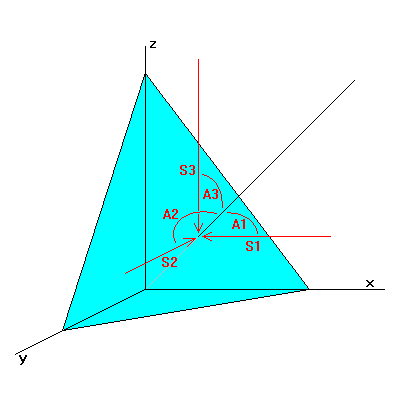 |
We have three principal stresses, S1, S2 and S3 acting along the x, y, and z axes, respectively.
We also have a plane whose pole makes angles A1, A2, and A3 with the x, y, and z axes, respectively. Assume the plane has unit area. Obviously, the direction cosines of the plane and its pole are cos A1, cos A2 and cos A3. A relationship we will use a lot is Life will be a lot simpler if we define c1 = cosA1, c2 = cosA2 and c3 = cosA3. |
We want to determine the normal and shear stresses on the plane. The normal stresses are easiest. Unfortunately, we can't add stresses, only forces, so we have to determine the forces the stresses exert, add them up, then convert back to stress.
Consider stress S1. It acts along the X1 axis, .but the stress "sees" only the area of the plane visible along the X1 axis, which is c1. So F1 = S1c1. Similarly, F2 = S2c2 and F3 = S3c3. The force normal to the plane exerted by F1 is F1c1, and the total force normal to the plane is F1c1 + F2c2 + F3c3. Since F1 = S1c1, we find:
Fn = S1c12 + S2c22 + S3c32
Furthermore, stress = force/area, but the area of the plane is one, so we have
Sn = S1c12 + S2c22 + S3c32
Determining shear stress can be a lot messier, if we do things the brute force way. Or we can do it the easy way.
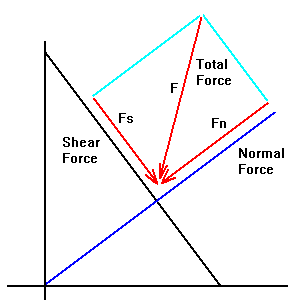 |
Here we are looking in the plane of the normal and shear forces. It's obvious from the vector diagram that F2 = Fn2 + Fs2.
Since the plane has an area of one and stress = force per unit area, we have F2 = Sn2 + Ss2. Note that it's only the magnitudes of the stresses that we are adding. Stresses do not add vectorially! The total force F can be found from the three vectors F1, F2 and F3 above. Since these three components are mutually perpendicular, we have F2 = F12 + F22 + F32 or Sn2 + Ss2 = S12c12 + S22c22 + S32c32 (this will be very useful a bit later) |
So we have:
Ss2 = F2 - Sn2 = F12 + F22 + F32 - (S1c12 + S2c22 + S3c32)2
= S12c12 + S22c22 + S32c32 - (S1c12 + S2c22 + S3c32)2
= S12c12 + S22c22 + S32c32 - S12c14 - S22c24 - S32c34 - 2S1S2c12c22 - S2S3c32c22 - S3S1c12c32
We regroup terms to get:
Ss2 = S12c12(1 - c12) + S22c22(1 - c22) + S32c32(1 - c32)
- 2S1S2c12c22 - S2S3c32c22 - S3S1c12c32
Now, since 1 - c12 = c22 + c32, we can rewrite the above as:
Ss2 = S12c12(c22 + c32) + S22c22(c32 + c12) + S32c32(c22 + c12)
- 2S1S2c12c22 - S2S3c32c22 - S3S1c12c32
Gathering terms, we get
= (S12 - 2S1S2 + S22)c12c22 + (S22 - 2S2S3 + S32)c32c22 + (S32 - 2S3S1 + S12)c12c32
Ss2 = (S1 - S2)2c12c22 + (S2 - S3)2c32c22 + (S1 - S3)2c12c32
Mohr Circles in Three Dimensions
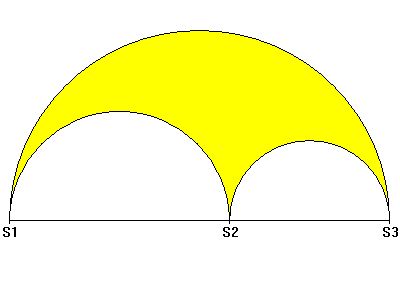 |
If the principal stresses are S1, S2 and S3, we can plot Mohr Circles for stresses in the S1-S2, S2-S3 and S1-S3 planes. For some plane oblique to all three principal stresses, the stress state will plot somewhere in the yellow area. But where?
Most textbooks treat this construction as a "black box," without proof, as if the Gods of structural Geology handed it down from Mount Olympus back in the Age of Heroes, and mere mortals of our corrupt age could not possibly derive it. In fact, there is a remarkably simple derivation. |
We found above that
Sn = S1c12 + S2c22 + S3c32
Ss2 = (S1 - S2)2c12c22 + (S2 - S3)2c32c22 + (S3 - S1)2c12c32
We have formulas for Sn and Ss. Now you can eliminate c2 and c3 one at a time and get a formula involving just c1. Let me know how long it takes you. Here's where an ounce of mathematical intuition outweighs a ton of brute force.
- We expect our final result to be consistent with Mohr Circles, and therefore we expect a formula involving Ss2 and Sn2.
- The expansion for Ss2 has a lot of cross terms involving products like S1S2, etc. We also get the same cross products if we square Sn, so we see a way to eliminate a lot of terms.
- If we expand Sn2 and add it to Ss2, it collapses neatly, but we already have a formula for Ss2 + Sn2 from our derivation of the general formulas for shear and normal stress above. So we can simply write:
Ss2 + Sn2 = S12c12 + S22c22 + S32c32
We can get rid of most of the c2 and c3 terms by subtracting (S2 + S3)Sn. We get:
Ss2 + Sn2 - (S2 + S3)Sn = (S12c12 + S22c22 + S32c32) - (S1S2c12 - S22c22 - S3S2c32) - (S1S3c12 - S2S3c22 - S32c32)
Ss2 + Sn2 - (S2 + S3)Sn = S12c12 - S1S2c12 - S3S2c32 - S1S3c12 - S2S3c22
At first glance, this looks like a step backward. We still have terms in c2 and c3, and we actually have more terms than we started with. Also, we've introduced a first order term in Sn on the left side of the equation. But the terms in c2 and c3 have the same coefficient.
Ss2 + Sn2 - (S2 + S3)Sn = S12c12 - S1S2c12 - S1S3c12 - S2S3(c22 + c32)
We can use the fact that c22 + c32 = 1 - c12 to eliminate both c2 and c3 in one shot. Just try to do it piecemeal!
Ss2 + Sn2 - (S2 + S3)Sn =
S12c12 - S1S2c12 - S1S3c12 - S2S3(1 - c12)
Ss2 + Sn2 - (S2 + S3)Sn =
S12c12 - S1S2c12 - S1S3c12 + S2S3c12 - S2S3
Ss2 + Sn2 - (S2 + S3)Sn = (S1(S1 - S2) - S3(S1 - S2))c12 - S2S3
Ss2 + Sn2 - (S2 + S3)Sn = (S1 - S3)(S1 - S2)c12 - S2S3
Now, we still have the Sn term to deal with, but that's easily fixed by the standard quadratic equation method of completing the square. We note that x2 + 2ax = (x + a)2 - a2. So we can write
Ss2 + Sn2 - (S2 + S3)Sn + [(S2 + S3)/2]2 = (S1 - S3)(S1 - S2)c12 - S2S3 + [(S2 + S3)/2]2
Ss2 + [Sn - (S2 + S3)/2]2 = (S1 - S3)(S1 - S2)c12 - S2S3 + [(S2 + S3)/2]2
Ss2 + [Sn - (S2 + S3)/2]2 = (S1 - S3)(S1 - S2)c12 - S2S3 + (S22 + 2S2S3 + S3)/4
Ss2 + [Sn - (S2 + S3)/2]2 = (S1 - S3)(S1 - S2)c12 + (S22 - 2S2S3 + S3)/4
Ss2 + [Sn - (S2 + S3)/2]2 = (S1 - S3)(S1 - S2)c12 + [(S2 - S3)/2]2
This has the form y2 + (x - a)2 = r2, which is the formula for a circle centered at x = a, y = 0. This particular circle is centered at (S2 + S3)/2, meaning it is concentric with the S2-S3 circle. This arc is the locus of all stress states for planes whose pole makes an angle A1 with stress S1. We can also find analogous arcs for A2 and S2, and A3 and S3. The intersection of the loci gives the state of stress for the plane in question.
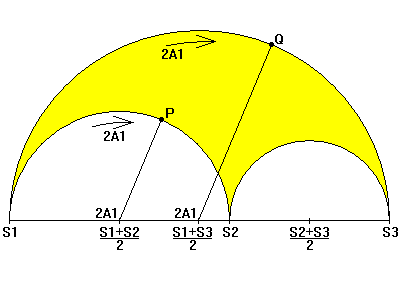 |
We can calculate the radius, but there's an easier way. We simply note that for planes whose poles are in the S1-S3 plane and the S1-S2 plane, the stress state plots at 2A1 from S1, in other words at P and Q. |
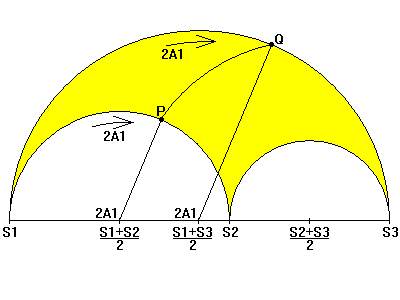 |
Therefore the circle is centered at (S2 + S3)/2 and passes through points P and Q, which are located 2A1 away from S1 on the S1-S2 and S1-S3 circles. |
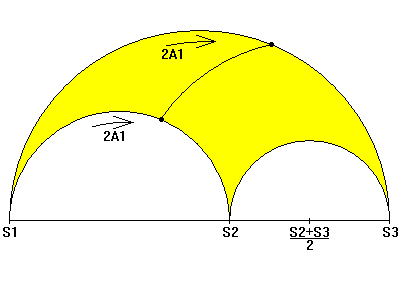 |
Here are the rules. The stress state for A1 lies on a circle that:
|
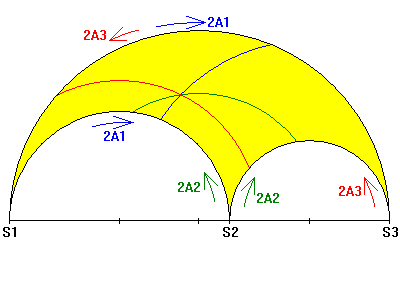 |
The rules and formulas for A2 and A3 are exactly analogous. In each case:
|
Return to Course Syllabus
Return to Techniques Manual Index
Return to Professor Dutch's Home Page
Created 15 November 2004, Last Update
12 June 2020